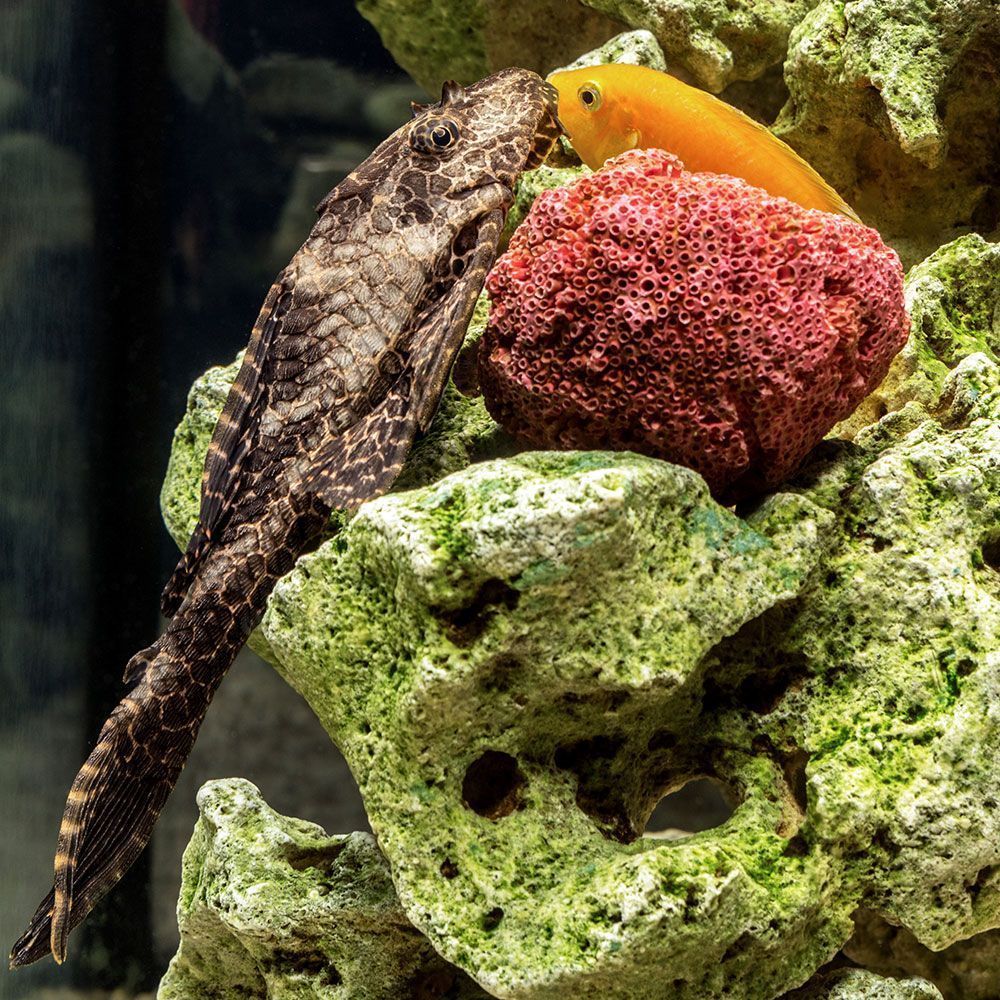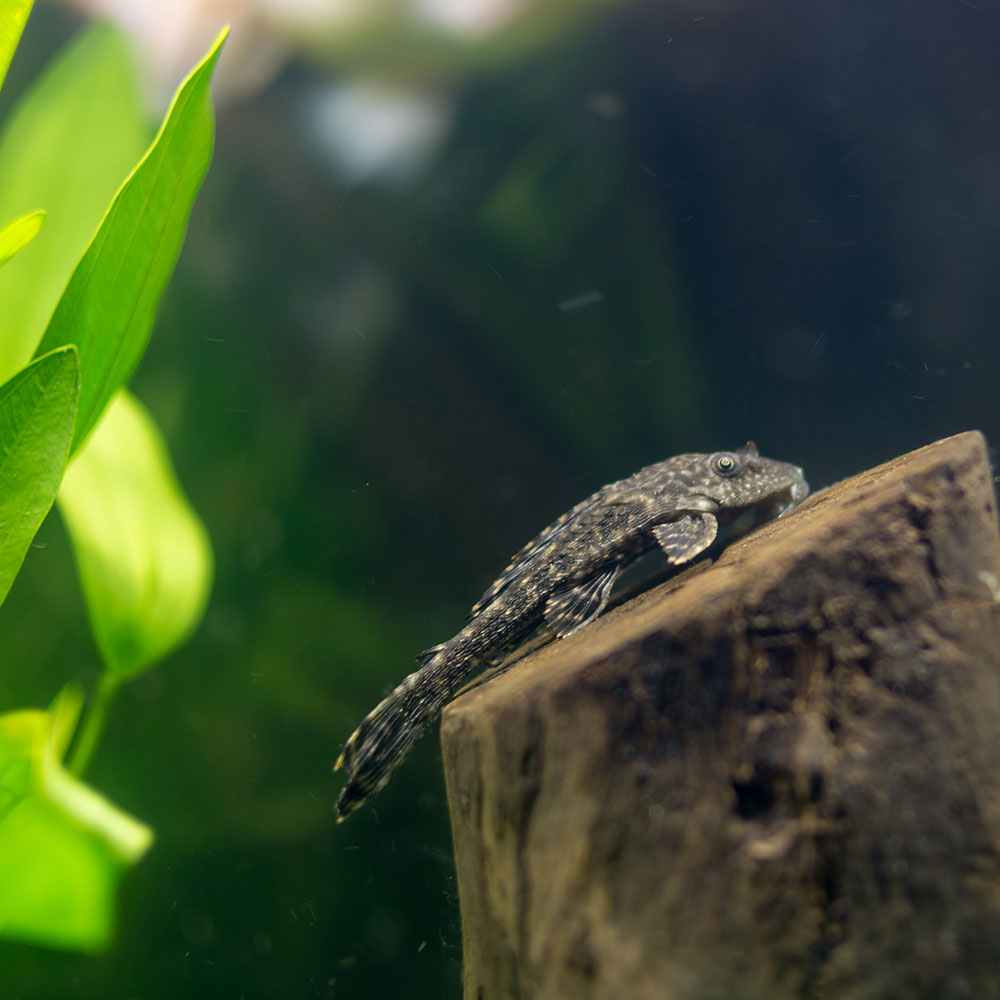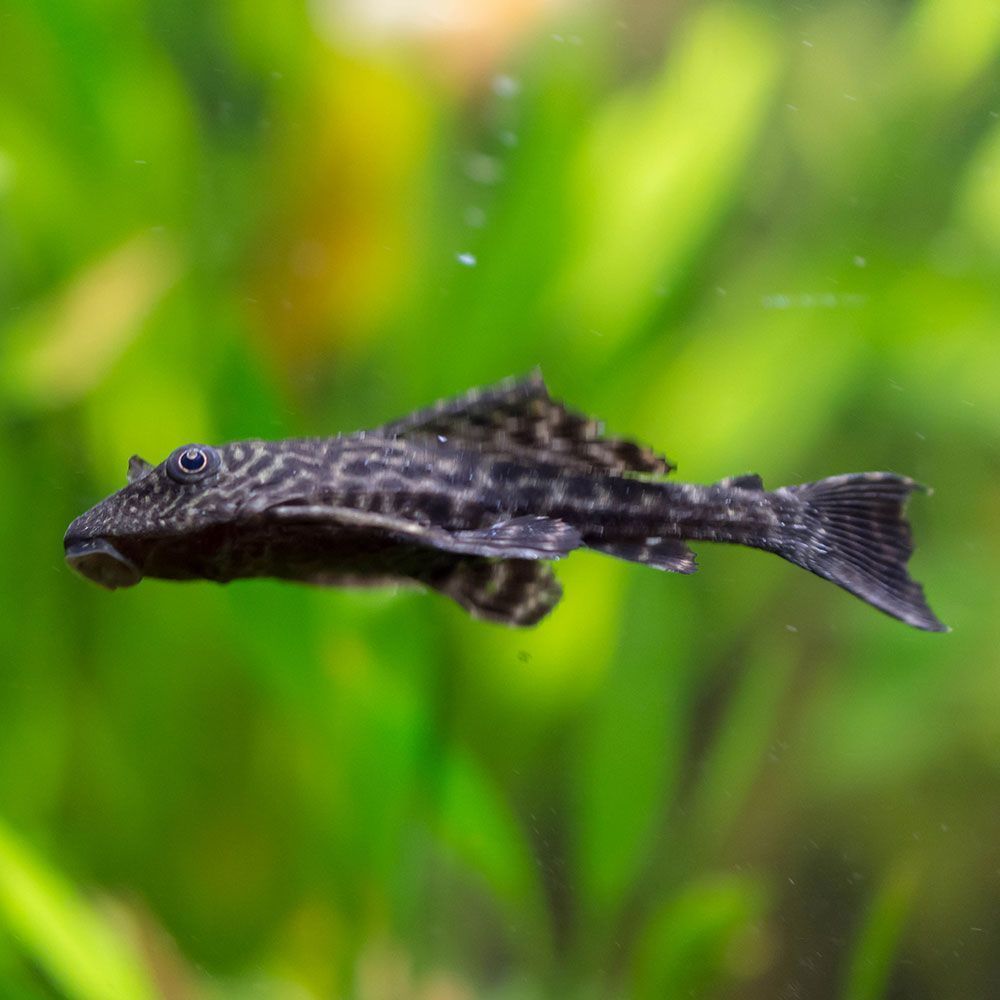If you are intrigued by plecos and want to add one to your tank, you can never go wrong with a sailfin pleco. It is a great addition to a large community aquarium with well-researched species.
The handsomely patterned catfish is exceptionally hardy, which makes it an excellent choice for a novice with large tanks.
If you’re one of them, keep reading. This think-piece will tell you all about its appearance, care guide, lifespan and everything else in between.
What is a Sailfin Pleco Fish?
| Origin | Amazon River and Orinoco River – middle and upper basins, South America |
| Order | Siluriformes |
| Family | Loricariidae |
| Scientific Name | Pterygoplichthys gibbiceps |
| L Number | L165 |
| Common Names | Sailfin pleco, Gibby, Leopard sailfin pleco |
| IUCN Red List Status | Not Evaluated |
| Appearance | Orange base body color with black condensed spots all over |
| Size | Up to 50 cm (19.7 in) |
| Lifespan | Up to 15 years in captivity and over 20 years in the wild |
| Temperament | Peaceful towards non-territorial species Slightly aggressive towards territorial species |
| Tank Level | Bottom dwellers |
| Water Temperature | 73-81 °F (23-27 °C) |
| pH Level | 6.0-7.8 |
| Water Hardness | 5-19 dGH |
| Care Level | Easy |
| Minimum Tank Size | Minimum 150 gallons for one |
| Tank Environment | Spacious, shaded, dimly lit, with floating plants and driftwood |
| Diet | Omnivorous |
| Tank Mates | Smaller, non-territorial, non-aggressive, and upper-level dwelling species |
Where is Sailfin Pleco Fish Found?
The sailfin pleco typically inhabits the South American nations of Brazil and Venezuela. It is usually spotted in the upper and middle basins of the Orinoco River and Amazon River. But sometimes, you might also spot it in the Negro River.
Which family does Sailfin Pleco Fish belong?
The species belongs to the order Siluriformes and family Loricariidae.
Usually, it’s popular by the scientific name Pterygoplichthys gibbiceps. However, it also had other scientific names like Ancistrus gibbiceps, Glyptoperichthys gibbiceps, and Liposarcus altipunnis.
In the aquarium trade, it is commonly known as Sailfin Pleco, L165, and Gibby. The fish also has some other Danish and German names.
It is also known as Leopard Sailfin Pleco, not to be confused with Leopard Frog Pleco (Peckoltia compta) (L134) or Brown Dot Pleco (Peckoltia oligospila) (L006).
Fun Fact: It is a great fish to control algae growth in the tank. Sometimes, it even eats its dead tank mates.
How do Sailfin Pleco Fish Look?

Overall, this fish looks like any other pleco, but let’s get down to the fine details that’ll help you distinguish.
What is the Size of Sailfin Pleco Fish?
The adult sailfin is found to be at most 50.0 cm (19.7 in) long.
What is the Color of Sailfin Pleco Fish?
Like a leopard, the pleco has a faded orange color as its base, along with consistent black to brown spots all over its body. Thus its name is “Leopard Sailfin Pleco”.
Due to this pattern, it can blend in with the surroundings of your tank.
What are the Morphs of Sailfin Pleco Fish?
There is also an albino variant of the sailfin. It seems to have a faint orange base color and off-white to cream spots on the body. At a glance or from afar, the fish may seem unicolor. Moreover, it has transparent fins and red eyes.
What are the Features of Sailfin Pleco Fish?
Like every other pleco, the sailfin looks the same with a sucker mouth on its bottom side. But that alone isn’t enough to identify it.
You need to look for other features, like, this fish has more than 10 dorsal rays, unlike the others (similar-looking ones like Hypostomus species) that have 8 dorsal rays (maximum). The first ray is almost equal to its head length.
There are consistently sized and patterned spots on its fins, underbelly, and head, unlike the others.
It also has a large dorsal fin with great height and a massive surface area. It extends from its back to the beginning of its caudal peduncle.
How is a male and a female Sailfin Pleco Fish different?
In the adult male fish, the genital papilla is a protruding thick and small stump, observed at the undercarriage of the fish.
In the same area, the female fish has a genital papilla that isn’t protruding or looks as though it’s recessed or lies flat.
However, only a trained aquarist in plecos can identify these differences with absolute certainty.
What is the Behavior of Sailfin Pleco Fish?
Sailfin pleco’s temperament depends on its tank mates. For instance, it is peaceful with smaller species that mind their own business.
But it can’t always bear its own species, and fights are especially regular among males.
It is also aggressive towards other territorial species.
Further, it is a primarily nocturnal species, i,e., it is more active at night, but sometimes, it may surprise you by being active during the day.
What is the Lifespan of Sailfin Pleco Fish?
The fish lives up to 15 years in captivity and even more than 20 years in the wild.
Author’s Note: The fish is popular for sucking slime from the body of other large fish like discus and freshwater angelfish, especially when the other fish is asleep. This may lead to trouble in the tank.
How to take care of Sailfin Pleco Fish?

Now, if you have made up your mind to bring this fish home, then let’s prepare a lovely home for it.
What is the Tank Size of Sailfin Pleco Fish?
The young fish can adjust in average community tanks as long as it is small. As soon as it grows to its full size, it needs a tank of at least 200 cm in length.
Some aquarists recommend a 100-gallon tank. But according to my experience, a tank size of 150 gallons is ideal as the fish will have more space to explore.
What is the Water Chemistry for Sailfin Pleco Fish?
Though it doesn’t fuss much about the water parameters, you must still follow these to sustain it for the longest.
- pH Levels: 6.0-7.8
- Water Temperature: 73-81 °F (23-27 °C)
- Water Hardness: 5-19 dGH
- Ammonia: 0 ppm
- Nitrite: 0 ppm
- Nitrate: Below 30 ppm
What is the Tank Environment for Sailfin Pleco Fish?
Next, your task is to make the fish feel at home and create a safe space for it. So, follow these tips here!
Which Substrate to choose for Sailfin Pleco Fish?
Plecos don’t have scales and only have armor-like hard plates. It crawls all over the substrate, looking for food, so choose a soft and fine sand substrate.
It sucks on algae growth in the tank, so avoid using small gravel, even if it’s smooth; otherwise, it may swallow the rock.
Which Plants to choose for Sailfin Pleco Fish?
The fish is primarily a herbivore, even in its natural habitat. So, don’t fix any fancy plants on the tank bottom. Instead, add floating plants to diffuse the light like in the wild. No need to create a heavily vegetated tank.
Which Lighting is best suitable for Sailfin Pleco Fish?
Go for moderate lighting to make it feel at home.
What Décor to choose for Sailfin Pleco Fish?
The species prefers to spend time in the nooks and crannies, so put some driftwood or birchwood in the tank bottom. Since it likes herbivorous meals, it may also munch on the wood.
You can also add appropriately sized caves for it to rest.
Which filter should a Sailfin Pleco Fish Tank have?
Always go for a strong oxygenating filter to keep your sailfin pleco alive and cheerful.
What is the Water Flow Rate for Sailfin Pleco Fish?
It is known to live in fast-flowing waters, so medium to high current in the tank is preferred.
Fish Care Tip: The fish excretes lots of waste, so filtration alone won’t help. So, perform 10-15% water change every alternate week.
What does Sailfin Pleco Fish Eat?
In the wild, this pleco is more inclined to munch on herbivorous meals. But in captivity, to maintain good health, you must always keep the fish on a balanced omnivorous diet.
A majority of its diet needs to be different types of algae. The fish also feeds on algal growth in the tank, but that’s never enough to fill it. So, provide it the following:
- Cucumber
- Zucchini
- Algae wafers
- Sinking pellets
- Bloodworms
- Small larvae
- Brine shrimp
- Small crustaceans
- Other freeze-dried or live meaty treats
Remember that its diet must be primarily herbivorous. You can occasionally add a variety of carnivorous feed but never go overboard with it.
Never overfeed your finny companion or else it may cause health issues from bloating. The leftover feed might rot and sharply spike nitrate levels in the tank.
Dietary Tip: The fish is a competitive eater, so notice whether other tank mates get enough food. If not, try to feed the others when the fish is inactive.
What are the Tank Mates for Sailfin Pleco Fish?
The best tank mates of this species are peaceful, slow, and smaller species. Some of the possible options are:
- Small tetras (black skirt tetra, congo tetra, and bloodfin tetra)
- Small loaches (clown loach and kuhli loach)
- Peaceful and small gouramis (honey gourami, sparkling gourami, and pearl gourami)
- Silver dollar fish
- Red cherry shrimp
- Freshwater crabs
Sometimes, it can also be housed with other sailfin plecos, but there’s a catch…
This is possible only if the sailfins are brought up together right from the beginning. If you suddenly house two or more of them together, a fight may break out.
Which Tank Mates to Avoid for Sailfin Pleco Fish?
Some incompatible tank mates for this species are:
- Fast-swimming and fin-nipping species: The pleco is too slow to protect its fins from harm around these.
- Territorial aggressive species: It becomes aggressive toward any species threatening its space.
- Similarly-sized species: Since they also need space, the pleco always stays alert around them.
- Bottom-dwellers: Especially if the tank has only enough bottom area for the pleco to live comfortably.
What are the Common Diseases in Sailfin Pleco Fish?
Usually, sailfins are popular for being hardy and disease-resistant. But a sharp change in water can affect them seriously. So, to protect your fin buddy, keep an eye on these symptoms and be prepared ahead of time.
| Disease Name | Causes | Symptoms | Treatment |
|---|---|---|---|
| Ich | Protozoan parasitic infection | White spotting, flashing, appetite loss, tiredness | Temperature elevation, medicine |
| Fin rot | Bacterial infection | Fin fraying and disintegrating, redness or discoloration of fins, appetite loss, tiredness | Water quality improvement, removing physically injurious objects, medicine |
| Columnaris | Bacterial infection | White to grey patches, fin fraying, appetite loss, tiredness | Water quality enhancement, stress reduction, medicine |
| Dropsy | Stress, polluted water, infection | Bloated belly, skin redness near the vents and fins, ulcers | Regular water changes, medicine |
Quick Tip: The fish is susceptible to potassium permanganate and copper medicines due to its lack of scales. So, make sure you get medicines dedicated to this species. Moreover, quarantine your fish and maintain a healthy diet for quick recovery.
How to Breed Sailfin Pleco Fish in Aquarium?
It’s pretty difficult to breed this species in home aquariums due to the unattainable conditions. However, if you’re curious about how they breed in the wild and mimic it, here is some crucial information:
It sexually matures around 5 years of age and 3 inches in length.
The species need an extremely muddy environment to breed. Both male and female fish buries themselves in the mud.
Once the female is ready, she digs further into a mud wall until a tunnel is formed and lays more than 500 eggs. The male follows behind to fertilize those. After that, he guards the eggs until they hatch.
Aquarists in Southeast Asia and Florida breed it in large ponds. However, it’s advised not to try it unless you’re certain about the water chemistry or have a pro-aquarist to help you.
Breeding Tip: If you can’t identify the genders of the pair and mistakenly put two males together, you might lose them both. So, avoid breeding them unless you have the knowledge.
A word from FishInAquarium
After reading it all, you probably know that a sailfin pleco is an extremely easy-to-. The interesting-looking fish is low-maintenance, so long you prepare the basics for it. If you have the proper tank or the funds to upgrade, this is a great choice.
If you feel confident getting the fish with all this knowledge, share it with other enthusiasts. Let others also show some love to this species. And if your mind is boggling with questions, mail us and we’ll answer you ASAP!


